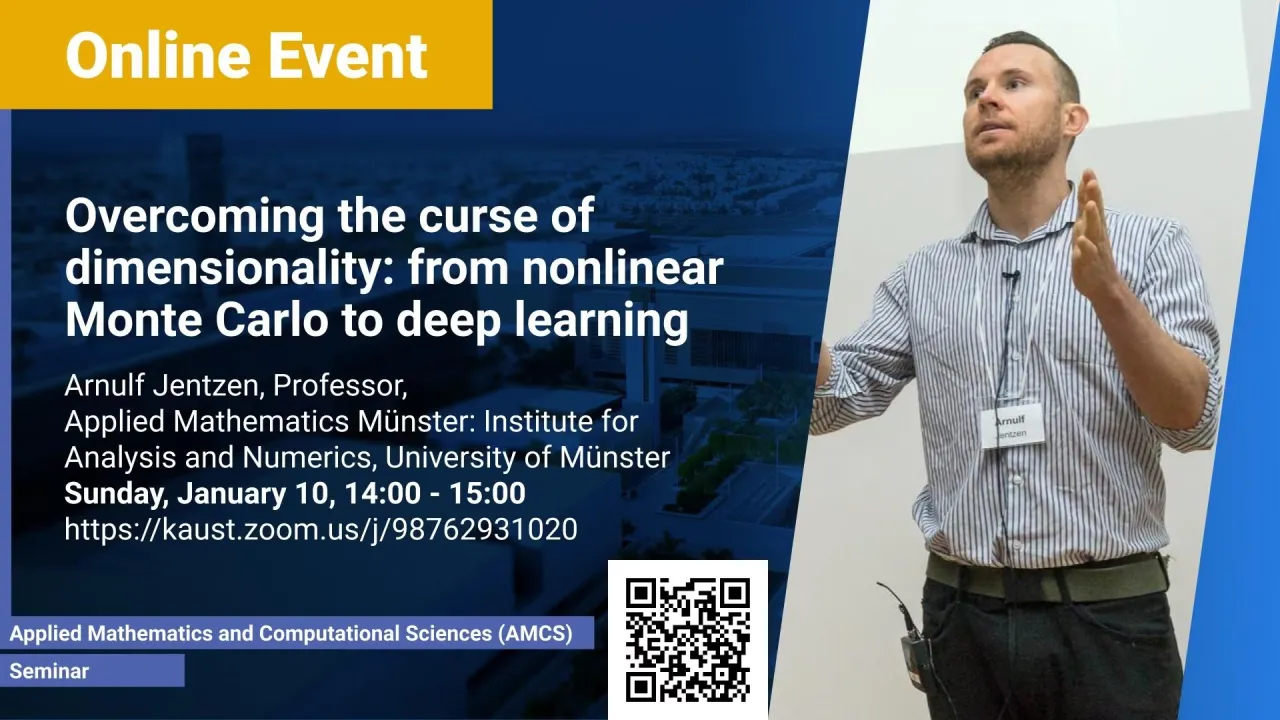
Overcoming the curse of dimensionality: from nonlinear Monte Carlo to deep learning
- Arnulf Jentzen, Professor, Applied Mathematics Münster: Institute for Analysis and Numerics, University of Münster
KAUST
In this talk we prove that suitable deep neural network approximations do indeed overcome the curse of dimensionality in the case of a general class of semilinear parabolic PDEs and we thereby prove, for the first time, that a general semilinear parabolic PDE can be solved approximatively without the curse of dimensionality.
Overview
Abstract
Partial differential equations (PDEs) are among the most universal tools used in modeling problems in nature and man-made complex systems. For example, stochastic PDEs are a fundamental ingredient in models for nonlinear filtering problems in chemical engineering and weather forecasting, deterministic Schroedinger PDEs describe the wave function in a quantum physical system, deterministic Hamiltonian-Jacobi-Bellman PDEs are employed in operations research to describe optimal control problems where companies aim to minimize their costs, and deterministic Black-Scholes-type PDEs are highly employed in portfolio optimization models as well as in state-of-the-art pricing and hedging models for financial derivatives. The PDEs appearing in such models are often high-dimensional as the number of dimensions, roughly speaking, corresponds to the number of all involved interacting substances, particles, resources, agents, or assets in the model. For instance, in the case of the above-mentioned financial engineering models, the dimensionality of the PDE often corresponds to the number of financial assets in the involved hedging portfolio. Such PDEs can typically not be solved explicitly and it is one of the most challenging tasks in applied mathematics to develop approximation algorithms that are able to approximatively compute solutions of high-dimensional PDEs. Nearly all approximation algorithms for PDEs in the literature suffer from the so-called "curse of dimensionality" in the sense that the number of required computational operations of the approximation algorithm to achieve a given approximation accuracy grows exponentially in the dimension of the considered PDE. With such algorithms it is impossible to approximatively compute solutions of high-dimensional PDEs even when the fastest currently available computers are used. In the case of linear parabolic PDEs and approximations at a fixed space-time point, the curse of dimensionality can be overcome by means of Monte Carlo approximation algorithms and the Feynman-Kac formula. In this talk we prove that suitable deep neural network approximations do indeed overcome the curse of dimensionality in the case of a general class of semilinear parabolic PDEs and we thereby prove, for the first time, that a general semilinear parabolic PDE can be solved approximatively without the curse of dimensionality.
Brief Biography
Since 2019 Arnulf Jentzen (*November 1983) is employed as a Full Professor for Applied Mathematics at the University of Muenster. In 2004 he started his undergraduate studies in mathematics (minor field of study: computer science) at Goethe University Frankfurt in Germany and in 2009 he completed his Ph.D. at this university. The core research topics of his research group are machine learning approximation algorithms, computational stochastics, numerical analysis for high dimensional partial differential equations (PDEs), stochastic analysis, and computational finance. He is particularly interested in deep learning-based algorithms for high dimensional approximation problems and different kinds of differential equations. The research activities of his group cover the full spectrum ranging from a rigorous mathematical error analysis to concrete implementations. Currently, his research group consists of one postdoctoral fellow and eight Ph.D. students. At the moment he serves as an associate/division editor for the Annals of Applied Probability (AAP, since 2019), for Communications in Mathematical Sciences (CMS, since 2015), for the Journal of Complexity (JoC, since 2016), for the Journal of Mathematical Analysis and Applications (JMAA, since 2014), for the SIAM / ASA Journal on Uncertainty Quantification (JUQ, since 2020), for the SIAM Journal on Scientific Computing (SISC, since 2020), for the SIAM Journal on Numerical Analysis (SINUM, since 2016), for the Journal Springer Nature Partial Differential Equations and Applications, and for the Journal of Applied Mathematics and Physics (ZAMP, since 2016). He has received a series of awards and prizes. Most notably, in 2020 he has been awarded the Felix Klein Prize from the European Mathematical Society (EMS).